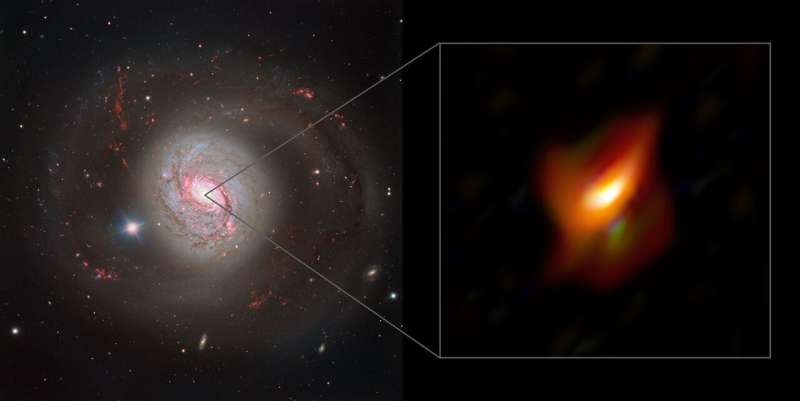Supermassive black hole caught hiding in a ring of cosmic dust

The European Southern Observatory's Very Large Telescope Interferometer (ESO's VLTI) has observed a cloud of cosmic dust at the center of the galaxy Messier 77 that is hiding a supermassive black hole. The findings have confirmed predictions made around 30 years ago and are giving astronomers new insight into active galactic nuclei, some of the brightest and most enigmatic objects in the universe.
Active galactic nuclei (AGNs) are extremely energetic sources powered by supermassive black holes and found at the center of some galaxies. These black holes feed on large volumes of cosmic dust and gas. Before it is consumed, this material spirals toward the black hole and huge amounts of energy are released in the process, often outshining all the stars in the galaxy.
Astronomers have been curious about AGNs ever since they first spotted these bright objects in the 1950s. Now, thanks to ESO's VLTI, a team of researchers led by Violeta Gámez Rosas from Leiden University in the Netherlands has taken a key step toward understanding how they work and what they look like up close. The results are published today in Nature.
By making extraordinarily detailed observations of the center of the galaxy Messier 77, also known as NGC 1068, Gámez Rosas and her team detected a thick ring of cosmic dust and gas hiding a supermassive black hole. This discovery provides vital evidence to support a 30-year-old theory known as the unified model of AGNs.
Astronomers know there are different types of AGN. For example, some release bursts of radio waves while others don't; certain AGNs shine brightly in visible light, while others, like Messier 77, are more subdued. The unified model states that despite their differences, all AGNs have the same basic structure: a supermassive black hole surrounded by a thick ring of dust.
According to this model, any difference in appearance between AGNs results from the orientation at which we view the black hole and its thick ring from Earth. The type of AGN we see depends on how much the ring obscures the black hole from our view point, completely hiding it in some cases.
Astronomers had found some evidence to support the unified model before, including spotting warm dust at the center of Messier 77. However, doubts remained about whether this dust could completely hide a black hole and hence explain why this AGN shines less brightly in visible light than others.
"The real nature of the dust clouds and their role in both feeding the black hole and determining how it looks when viewed from Earth have been central questions in AGN studies over the last three decades," explains Gámez Rosas. "Whilst no single result will settle all the questions we have, we have taken a major step in understanding how AGNs work."
The observations were made possible thanks to the Multi AperTure mid-Infrared SpectroScopic Experiment (MATISSE) mounted on ESO's VLTI, located in Chile's Atacama Desert. MATISSE combined infrared light collected by all four 8.2-meter telescopes of ESO's Very Large Telescope (VLT) using a technique called interferometry. The team used MATISSE to scan the center of Messier 77, located 47 million light-years away in the constellation Cetus.
"MATISSE can see a broad range of infrared wavelengths, which lets us see through the dust and accurately measure temperatures. Because the VLTI is, in fact, a very large interferometer, we have the resolution to see what's going on, even in galaxies as far away as Messier 77. The images we obtained detail the changes in temperature and absorption of the dust clouds around the black hole," says co-author Walter Jaffe, a professor at Leiden University.
Combining the changes in dust temperature (from around room temperature to about 1200 degrees Celsius) caused by the intense radiation from the black hole with the absorption maps, the team built up a detailed picture of the dust and pinpointed where the black hole must lie. The dust—in a thick inner ring and a more extended disk—with the black hole positioned at its center supports the unified model. The team also used data from the Atacama Large Millimeter/submillimeter Array, co-owned by ESO, and the National Radio Astronomy Observatory's Very Long Baseline Array to construct their picture.
"Our results should lead to a better understanding of the inner workings of AGNs," concludes Gámez Rosas. "They could also help us better understand the history of the Milky Way, which harbors a supermassive black hole at its center that may have been active in the past."
The researchers are now looking to use ESO's VLTI to find more supporting evidence of the unified model of AGNs by considering a larger sample of galaxies.
Team member Bruno Lopez, the MATISSE Principal Investigator at the Observatoire de la Côte d'Azur in Nice, France, says: "Messier 77 is an important prototype AGN and a wonderful motivation to expand our observing program and to optimize MATISSE to tackle a wider sample of AGNs."
ESO's Extremely Large Telescope (ELT), set to begin observing later this decade, will also aid the search, providing results that will complement the team's findings and allow them to explore the interaction between AGNs and galaxies.
This research was presented in the paper "Thermal imaging of dust hiding the black hole in the Active Galaxy NGC 1068," to appear in Nature.
More information: Violeta Gámez Rosas, Thermal imaging of dust hiding the black hole in NGC 1068, Nature (2022). DOI: 10.1038/s41586-021-04311-7. www.nature.com/articles/s41586-021-04311-7
Journal information: Nature
Provided by ESO





















